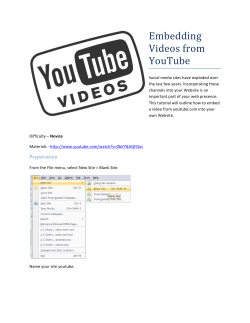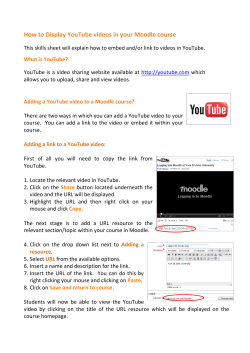
#2: Forms of Cultural Diversity HLTHIR403C
Work Effectively with diverse clients and co-workers HLTHIR403C #2: Forms of Cultural Diversity Lesson Outline •Cultural awareness at work •Cultural diversity is positive in the workplace Different Cultural Diversities • • • • • • • • Disabilities * Teen parents Obesity * Stay at home Dads Mental health * Location, location Homeless * Clothing/dress Age * Socio-economic Sexuality & Gender * Not the ‘norm’ Ethnicity Race What other aspects of diversity are there? People with Disabilities • Individuals with a physical or intellectual disability are treated differently from the ‘norm’, but this treatment is beyond the individual’s disability. – It is sometimes thought that people with a physical or intellectual disability do not have the same needs as someone without a disability. – Watch Youtube video: – Nick Vujicic, No Arms, No Legs, No Worries! Part 1 – http://www.youtube.com/watch?v=yo_24_qTNac People with Obesity • Currently our society is discriminating and almost vilifying individuals who have a weight issue or are bigger than what society considers to be the ‘norm’. • The media portrays visual images which ostracize and blame obese people for costing the health system so much. But is this true? Where does the media get it’s facts? What are the facts? • Are we becoming culturally discriminatory? (an accepted form of discrimination by society) Individuals with Mental Health Issues • Is stigma still attached to mental health issues? Individuals feel shame if they suffer from depression or anxiety. • Individuals with severe mental health issues are often ostracized or treated as outcasts. This adds to their shame. • A culturally competent society would support these individuals and ensure they join the ‘group.’ Senior Citizens • Seniors were once esteemed, revered and respected. • Seniority was viewed as being synonymous with ‘wisdom.’ • Changes in our societal attitudes are shunning ‘older people’ and in some instances the elderly are seen as being ‘past their use-by date.’ • Is this an attitude of a socially competent society? Sexuality & Gender Differences • Human sexuality is how people experience and express themselves as sexual beings. • Biologically, sexuality can encompass sexual intercourse and sexual contact in all its forms • Sociologically, it can cover the cultural, political, and legal aspects (in Australia sex under 16 years of age is illegal. • Philosophically, it can span the moral, ethical, theological, spiritual or religious aspects. Sexualisation of Children • Society encourages the expression of sexuality in certain set ways. The Child Beauty Pageants of the USA portray children as sexual adults. The young girls are dressed up as the ‘perfect stereotypical sexual woman’. This creates a lot of controversy and more recently in Australia a Child Beauty Contest was cancelled due to the protests outside the venue. • Activity: Watch U-Tube: Today Tonight story on Universal Royalty Pageant Australia http://www.youtube.com/watch?v=yTQ51p6QW1A Teen Parents • Teen parents feel ostracised by society. • However, society seems to have levels of acceptance. Often one child to teen parents is accepted, but two and three children to a teen parent is sometimes not accepted. • Does this mean, that society has levels of accepted? What does this say about our societal cultural competence? • Watch Youtube: Teenage parents - Babes - First Light • http://www.youtube.com/watch?v=5-ChyDrcizM Stay at Home Dads • Stay at home Dads are becoming more accepted in our society, but they are still a minority group and in some circumstances not accepted. • There seems to be several levels of expectation with ‘Stay at home Dads: – Men should be supporting their families – Men should be earning more than the female partner – Men don’t love or care as much about their children as their female counterparts. – Men don’t fit into “Mums’ Groups.” Location….Location….Location • Living in the ‘right area’ or ‘right side of town, is often considered a status symbol, i.e. Russell Crow’s house on the edge of Sydney Harbour overlooking the bridge and Opera House. • Location, location, location can be seen as an act of ‘snobbery?’ • Individuals will pay more to live in a certain area and this falsely increases land values, ensuring ‘inclusivity’ of only a certain financial standing. Clothing/dress • Individuals are often ‘labeled’ or ‘pigeon holed’ by the way they dress, i.e. Goths, who dress in black. – Any individuals who want to look or dress differently than what is considered socially acceptable. – Tattoos – Body piercings – Purple, bright metallic red or orange hair Being an individual dresser, may limit your employment opportunities, depending upon the area in which you work. Socio-economic Level Stigma • Certain areas are considered ‘low-socio-economic, and with that title, properties are valued and often so are the people who live in those areas. • Stigma is attached those ‘labels’, i.e. ‘bogans’. • Often low-socio-economic areas have high unemployment due to lack of public transport and infrastructure, and employment opportunities. Ethnicity Definition “Ethnicity involves a collection of values, beliefs and behaviours associated with an ethnic group or community. Ethnicity can influences the lives of members of the group to varying degrees and can include a wide range of values. Not everyone of a particular ethnicity will subscribe to all these values”. “It is rarely recognised that, consistent with this definition, there is an Australian ethnicity which includes a wide range of values, not all of which are held by all Australians. “ http://www.multiculturalaustralia.edu.au/hotwords/unpack/Ethnicity Race Definition “The term “race” is used to artificially classify people on the basis of supposed physical and cultural similarities coming from their common descent. Despite there being no biological basis, the idea of distinctive races still exists and is used, in many societies, as a basis for social action, a foundation of government policy and often as a justification for distinctive treatment of one group by another”. http://www.multiculturalaustralia.edu.au/hotwords/unpack/race Race “Race is used to emphasise assumed differences between groups of people and to explain particular behaviours expected of particular groups. In fact, the human species shares a common gene pool and there is much more genetic variation within members of so-called racial groups than there is between them” http://www.multiculturalaustralia.edu.au/hotwords/unpack/race Not the ‘Norm’ Families • What is ‘normal’, is decided upon what society accepts as normal. The branding of families shows the level of cultural competence in our society. • What different styles of family or groups of people are there, that do not ‘fit the norm?’ • Watch youtube: DIVERSITY DAVE • http://youtu.be/gc-eWbc7kDM Cultural Continuum References • • • • • • • Chatswood (1993).The conflict resolution network: Conflict resolution trainers manual – 12 skills) Chenoweth L & McAuliffe D 2011 The road to social work & human service practice, 3rd edn.,Cengage Learning Australia. Chapter 8 Comparing Different Cultures: Intercultural Communications - Rey Ty, online video, accessed 20th May 2012 http://www.youtube.com/watch?v=3gRXMzR_8BY Corey G, Corey MS & Callanan P 2011 Issues and ethics in the helping professions, 8th edn., Cengage Learning: Brookes/Cole , United States. Chapter 4 Cornelius, H & Faire, S. (1989). Everyone can win: How to resolve conflict. Simon & Schuster, Sydney Cross Cultural Communication , online video, accessed 20 May 2012 , http://www.youtube.com/watch?v=BrJTf97Ev8o&feature=results_main&playnext=1&list=PLF E9649EC6D77970C Culture and Communication-Low and High Context Cultures, online video, accessed 20 May, 2012, http://www.youtube.com/watch?v=8tIUilYX56E&feature=autoplay&list=PLFE9649EC6D77970 C&playnext=2 References • • • • • • • • • • • • Cultural Competence: Managing Your Prejudices, online video, accessed May 22, 2012. http://www.youtube.com/watch?v=E1MI_h0HIcw Cultural Diversity - Tips for communicating with cultural awareness, online video, accessed 20 May 2012, http://www.youtube.com/watch?v=ZDvLk7e2Irc&feature=related Diversity Dave, online video, accessed 26 May 2012, http://www.youtube.com/watch?v=gceWbc7kDM&feature=related Emotional Intelligence or Behaviorial Control? (part 2) , online video, accessed 23 May, 2012, http://www.youtube.com/watch?v=8W4kWPdcdUk&feature=related31 Erikson, E.H. (1974). Dimensions of a New Identity. New York: Norton Georgetown University: National Centre for Cultural Competence 200, ‘Cultural Competence: Definition & Conceptual Framework,’ Washington, accessed 24 May, 2012. http://nccc.georgetown.edu/foundations/frameworks.html#ccdefinition Goleman, D. (1995). Emotional Intelligence. London: Bloomsbury Publishing Goleman, D. (1998). Working with emotional intelligence. New York: Bantam Books. Hage, H. & Couch, R. (eds), 1999, The Future of Australian Multiculturalism, Research Inst. For Humanities and Soc. Sciences, Sydney University Healey, J., 2000, Multiculturalism Volume 126, Issues in Society, The Spinney Press, Thirroul, NSW Healey, J., 2000, Australia’s National Identity, Volume 133, Issues in Society, The Spinney Press, Thirroul, NSW References • • • • • • • • • Human Rights and Equal Opportunity Commission Fact sheet: Face the Facts: How diverse are Australians (section 6) Hodge B & O’Carroll J 2006 Borderwork in Multicultural Australia, Allen & Unwin Sydney Kenny S 2011 Developing communities for the future, 4th edn., Cengage Learning Australia. Chapter 9 Practice in human services organisations, Allen & Unwin, Australia. Chapter 6 Maidment J & Egan R (eds) 2009 Practice skills in social work & welfare, 2nd edn., Allen & Unwin, Australia. Chapter 9,11 Making Multicultural Australia, 2002. “Ethnicity”. Accessed May 23, 2012http://www.multiculturalaustralia.edu.au Managing Conflict - Thomas Kilmann Conflict Mode Instrument , online video, accessed 22 May, 2012, http://www.youtube.com/watch?v=QFf88IVl_Wc MDA Multicultural Development Association 2012, “Working as a culturally competent mental health practitioner”. Accessed May 22, 2012, http://aboriginal.childhealthresearch.org.au/media/54895/chapter12.pdf Nick Vujicic, No Arms, No Legs, No Worries! Part 1, online video, accessed 18 May 2012, http://www.youtube.com/watch?v=yo_24_qTNac References • • • • • • • • • O’Hara A & Pockett R (eds) 2011 Skills For Human Service Practice: Working with Individuals, Groups and Communities, 2nd edn., Oxford University Press, Australia/ New Zealand Racism. No Way! 2010. “Fact sheet: Australia's Cultural Diversity”, accessed May 24 2012 Sockalingum adapted from Hayes, Cultural Competence Continuum, 1993 and Terry Cross Cultural Competency Continuum “The secret world of the child bride: Heartbreaking pictures of the girls as young as FIVE who are married off to middle-aged men,” Daily Mail, accessed 24 April,2012, http://www.dailymail.co.uk/news/article-2001029/Child-brides-young-5-married-secretmiddle-aged-men.html#ixzz1pjEGZZYf Trudge R 2005 Why worriers lie down and die, P/l Darwin Segal J., Ph.D., Smith M., M.A., and Jaffe. J, Ph.D. Cited March 2012 , accessed 23 May, 2012, http://www.helpguide.org/mental/eq6_nonverbal_communication.htm Teenage parents - Babes - First Light, online video, accessed 21 May 2012 http://www.youtube.com/watch?v=5-ChyDrcizM Today Tonight story on Universal Royalty Pageant Australia , online video accessed 24 May 2012 http://www.youtube.com/watch?v=yTQ51p6QW1A What is your conflict style?, online video, accessed http://www.youtube.com/watch?v=hv9FEuk4Mhk&feature=related
© Copyright 2025










